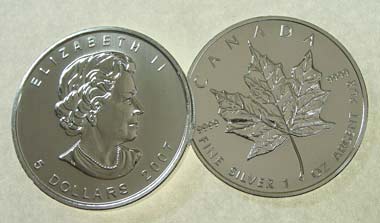More than a year ago, a little noticed article reported a study that found silver nano particles as found in silver colloids were able to kill HIV, in addition to a broad spectrum of viral bugs. Now, the US health authorities seem to have found a way to prevent this breakthrough from making it into broad public use. According to an article on NewsTarget.com, the Environmental Protection Agency is now selectively targeting nano silver - while practically ignoring pharmaceuticals and toxic chemical pesticides - as an environmental pollutant.

Tuesday, October 18, 2005 - FreeMarketNews.com
The Journal of Nanotechnology has published a groundbreaking study that found silver nanoparticles kills HIV-1 and is likely to kill virtually any other virus. The study, which was conducted by the University of Texas and Mexico University, is the first medical study to ever explore the benefits of silver nanoparticles, according to Physorg.
During the study, researchers used three different methods of limiting the size of the silver nanoparticles by using capping agents. The capping agents were foamy carbon, poly (PVP), and bovine serum albumin (BSA). The particles ranged in size from 1 to 10 nanometers depending on the method of capping. After incubating the HIV-1 virus at 37 C, the silver particles killed 100% of the virus within 3 hours for all three methods. The scientists believe that the silver particles bonded through glycoprotein knobs on the virus with spacing of about 22 nanometers in length.
While further research is needed, researchers are optimistic that nanological silver may be the silver bullet to kill viruses. The researchers in the study said that they had already begin experiments using silver nanoparticles to kill what is known as the super bug (Methicillin resistant staphylococcus aureus). Already used as a topical antibiotic in the medical industry, silver may now come under consideration as an alternative to drugs when it comes to fighting previously untreatable viruses such as the Tamiflu resistant avian flu.
According to NewsTarget, the EPA is using emerging regulations on the health effects of nano particles to selectively target colloidal silver products as "pesticides".
A friend who forwarded the article, commented that in the case of a bio weapons attack, silver would probably the most effective antidote. He says it is a real weapon of mass destruction, as far as pathogens are concerned, adding that at last count it will kill over 600 infectious agents on contact while being harmless to the human organism. The question he posits is: "Could this property of silver have something to do with the recent moves to keep this out of the hands of the public?
Here is the recent NewsTarget article:
- - -
EPA uses nanotech regulation ploy to target colloidal silver while ignoring all other nanotech particles
Nanomaterials -- products and materials changed or created at the atomic and molecular level -- are quickly gaining popularity for their multitude of uses, and while the Environmental Protection Agency is preparing to regulate popular nanosilver antibacterial products, ostensibly to protect consumers, critics say the move is a thinly veiled attempt to solely regulate nanosilver as a health supplement.
Nanosilver is used to kill harmful bacteria in food storage containers, shoe liners, washing machines and even bandages. Particles of nanosilver and other nanomaterials can be as small as one-millionth the size of a pinhead. However, the EPA, citing pressure from silver industry workers and environmental groups such as Natural Resources Defense Council, is investigating whether silver ions could pose an environmental threat by killing beneficial bacteria in the environment, or even harming humans. The agency also received a letter from Chuck Weir, chairman of a California wastewater treatment plant advisory group known as Tri-TAC, which claimed "silver is highly toxic to aquatic life at low concentrations and also bioaccumulates in some aquatic organisms, such as clams."
Silver was brought under close EPA scrutiny when washing machine manufacturers began making models that were lined with silver ions or sprayed them onto the clothes as an antibacterial agent. Last year, the EPA decided that the machines should not be regulated under the Federal Insecticide, Fungicide and Rodenticide Act, since they were considered devices rather than pesticides. Recently, however, the agency re-examined its decision and reversed it.
"We took a second look at the release of silver ions, and it was very clear that this is a pesticide and not a device," Jim Jones, director of the EPA's Office of Pesticide Programs, told the Washington Post. "Our original determination proved not to be a correct one."
Under the regulations, any silver product that claims it has antibacterial properties must prove the product is safe to be released into the environment. Mike Adams, a consumer health advocate and proponent of colloidal silver, suggested the regulations might work better were they aimed at antibiotics and pharmaceuticals.
read the rest of the article here...